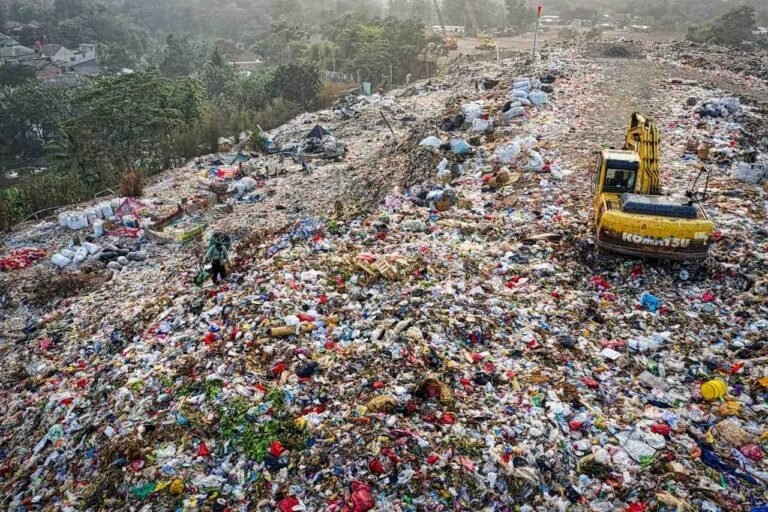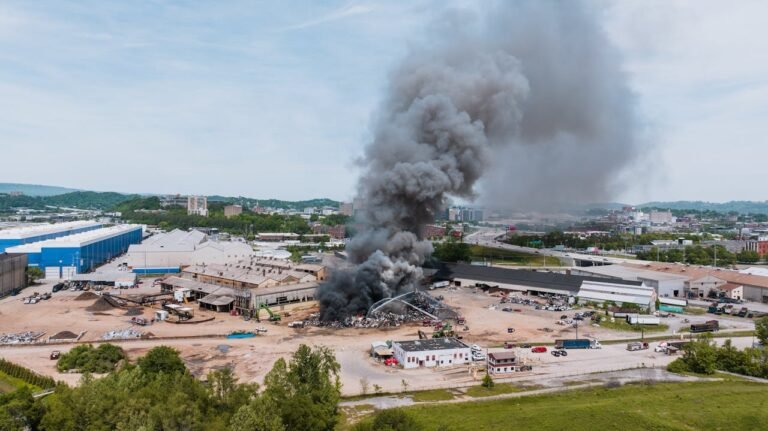Soil Pollution Causes and Remediation Techniques
Imagine planting a seed in hopeful soil, only to watch it struggle—not because you didn’t care, but because the ground itself is poisoned.
Soil isn’t just a passive layer beneath our feet. It’s a living, breathing foundation—supporting our food, ecosystems, clean water, and even human health. But after decades of unchecked industrial activity, harmful farming practices, and poor waste management, much of our soil has become dangerously contaminated.
This problem is far from abstract. According to a report published in the Financial Times, severe flooding in 2024 in North Yorkshire, U.K., stirred up lead from more than 8,500 abandoned mines, raising serious concerns about livestock poisoning and contaminating local drinking water supplies.
A global analysis suggests that about 14–17% of farmland—nearly 242 million hectares—is polluted with toxic heavy metals, putting the health of 1.4 billion people at risk. As the world advances with clean energy, the demand for metals like cobalt, nickel, and arsenic is rising rapidly, quietly exacerbating the crisis in our soil.
Understanding soil pollution isn’t just about statistics. It’s about recognising what’s at stake—and taking action to heal the ground we depend on.

In This Article
- What Is Soil Pollution?
- Root Causes: How Soil Becomes Poisoned
- Soil Remediation Techniques: How We Un-pollute
- Expert Voices
- What You Can Do: Actionable Advice
- Conclusion
What Is Soil Pollution?
Soil pollution occurs when harmful substances—such as heavy metals, pesticides, industrial waste, oil, or radioactive materials—accumulate in the soil at levels that pose risks to plants, animals, and humans. These pollutants can seep into the earth through industrial spills, excessive use of fertilisers and pesticides, improper waste disposal, mining activities, or even atmospheric deposition from polluted air.
Over time, contaminated soil loses its ability to support healthy plant life, disrupts ecosystems, and jeopardises food and water safety. It’s not just a local issue—it’s a global environmental and public health challenge that often goes unseen, literally buried beneath our feet.
Root Causes: How Soil Becomes Poisoned
1. Industrial Legacy
Industrial activity—factories, mining sites, and waste dumping—has laid down a toxic foundation for polluted soils. Heavy metals like lead, cadmium, and arsenic often seep into farmland. For instance, acid mine drainage continues to release sulfuric water rich in metals into agricultural zones — a stubborn legacy that can persist for decades.
Then there are petrochemical residues, solvents, and microplastics. “Forever chemicals” or PFAS, used in everything from non-stick cookware to industrial coatings, are particularly concerning. According to the EPA, many aren’t filtered out during wastewater treatment, so they end up in sewage sludge—then onto fields—posing long-term health risks from cancer to immune issues.
2. Unsustainable Agriculture
Modern intensive farming can simplify yields while complicating ecological balance. Phosphate-containing fertilisers often carry cadmium, a heavy metal toxic to humans and animals. Decades-scale studies show cadmium steadily accumulates in soils when phosphate fertilisers are repeatedly used, placing cadmium into crops and grazing lands.
A classic New Zealand study found that continuous superphosphate use over ten years led to a significant rise in soil cadmium, reflected in grass and animal tissue. Across 50 years of rice cultivation in Korea, cadmium levels in soil more than doubled under phosphate fertiliser regimes. Even short‑term experiments confirm that rising phosphate fertiliser rates increase plant‑available cadmium.
Pesticides are no less concerning. Though they boost yields, many residues persist, instead disturbing microbial diversity and soil food webs. Over time, these chemicals undermine the soil’s natural resilience, reducing fertility and harming long‑term plant health.
3. Urbanisation & Waste Mismanagement
As cities expand, so do their waste problems. Construction debris, leaking landfills, and illegal dumping steadily introduce pollutants into nearby soils. A shocking example: in parts of the UK, compost containing animal carcasses has been discovered on farmland — an alarming sign of mismanagement .
Even more concerning is how sewage sludge is treated. In the UK, some 87% of sludge is spread on fields but contains PFAS, microplastics, pharmaceuticals, flame retardants, and it’s barely regulated under guidance that dates back to 1989. An Environment Agency insider admitted the oversight is minimal, with guidance mostly ignoring emerging contaminants like microplastics and PFAS.
4. Climate Change & Extreme Weather
Climate change acts like a pollution conveyor belt. According to a 2024 Guardian report, Hurricane Helene flooded farms in western North Carolina, covering fields with toxic sludge, sewage, and industrial runoff. One farm lost its entire harvest under 1.2 meters of sand and waste. Experts warned of long-term risks to soil health and food safety.
At the other extreme, droughts evaporate moisture and concentrate salts and metals. A study in Agronomy for Sustainable Development found that drying–rewetting cycles increase toxic metal levels in soil pore water, harming microbes and crops.
Soil Pollution at a Glance
| Pollutant Type | Affected Area | Impacts |
|---|---|---|
| Heavy metals (As, Cd, Pb…) | ~242 M ha cropland (14–17%) | Cancer, kidney damage, birth defects |
| Lead | UK farms near ~8,500 abandoned mines | Lamb miscarriages, deaths, neurological harm |
| PFAS & biosolids | UK agricultural land | Accumulation of unknown toxins |
| Brownfield sites | ~500k in USA, ~90k in California | Gives rise to urban health and redevelopment challenges |
Soil Remediation Techniques: How We Un-pollute
1. Physical & Chemical Technologies
Dig‑and‑Haul
This method is straightforward: excavate polluted soil, truck it away, and backfill with clean material. It’s fast and reliable—ideal when time is short. But it’s disruptive, expensive, and risks spreading dust and contaminants. Plus, it simply moves the problem elsewhere rather than resolving it.
Soil Washing & Thermal Desorption
These ex‑situ techniques physically or thermally strip pollutants from soil. Soil washing uses water or chemical mixtures to separate contaminants, especially heavy metals, from particles. Thermal desorption heats soil to evaporate toxins, capturing them in vapour form. Both are effective but require treating large volumes, generating waste streams, and can consume significant energy.
Electrokinetic Extraction
In this emerging method, electric currents push charged contaminants—especially heavy metals and water‑soluble organics—toward electrodes, where they’re removed or neutralised. It’s well-suited for fine-grained soils, but scaling up can be complex and costly.
In Situ Chemical Oxidation (ISCO)
Injecting oxidising agents (like permanganate, persulfate, or hydrogen peroxide) into contaminated zones triggers chemical breakdown of organic pollutants such as solvents or petroleum. It’s less disruptive than excavation, works relatively quickly (weeks to months), and is cost-effective for localised contamination. However, ensuring thorough mixing in the ground can be tricky, and mismanagement might mobilise some contaminants unexpectedly.
2. Biological & Hybrid Solutions
Phytoremediation
This nature-led method uses plants to extract, degrade, or immobilise pollutants. Hyperaccumulators—such as sunflowers and Indian mustard—absorb heavy metals into their shoots. It’s cost-effective and sustainable, but it requires months to years, and only cleans within the plants’ root zones. Depth and pollutant type limit effectiveness.
Mycoremediation
Fungi are nature’s decomposers. Species like white-rot fungi and oyster mushrooms release powerful enzymes that break down complex pollutants—such as petroleum compounds and PAHs—into harmless substances. They can also sequester heavy metals directly into their mycelium or fruiting bodies. According to Wikipedia, fungi can handle a wide range of contaminants, from heavy metals to pesticides.
A particularly promising study from Italy focused on a novel fungus, Ciboria sp., found in soil around an old refinery. In controlled tests, researchers mixed tiny amounts of this fungus into heavily contaminated soil. With just 1–7 % fungal biomass, total petroleum hydrocarbons (TPH) dropped dramatically—78 % removal after 60 days and 99 % after 90 days in the stronger mixture. Notably, the fungus not only consumed contaminants directly but also encouraged helpful bacteria to flourish, amplifying overall cleanup.
Bioaugmentation & Bioventing
These utilise microbes—either naturally present or introduced—to biodegrade pollutants like BTEX (benzene, toluene, ethylbenzene, xylene) and PAHs. Bioventing delivers air or oxygen into the soil to stimulate microbial breakdown of organic compounds. Bioaugmentation introduces specialised, pollutant-eating bacteria into contaminated soil. These methods are powerful in degrading oil-based contaminants, especially on construction sites.
Case Study: Los Angeles “Solar‑Powered Vacuum Cleaners”
In L.A., researcher Dr. Danielle Stevenson planted native shrubs (California buckwheat, telegraph weed, mulefat) along with symbiotic fungi on brownfield sites contaminated with diesel and heavy metals. Within a year:
- Lead and arsenic concentrations in soil dropped substantially.
- Native fungi and plants fostered soil revival across sites.
- The project was embraced by Indigenous and environmental justice groups.
Stevenson described the plants as “solar‑powered vacuum cleaners,” drawing toxins from contaminated soils. Volunteers working on the project noted that the detoxified soil supported wildlife, including worms and birds—a return of life to areas previously marked by stagnation.
This phyto‑mycoremediation was slower than dig‑and‑haul, but avoided disrupting the land and minimized dust release. Crucially, community and Indigenous involvement shaped site selection and species choice, honouring cultural values and local stewardship. One tribal advisory leader noted that once data emerged, “tribes’ preference for bioremediation…was taken seriously.”
Arbuscular Mycorrhiza‑Assisted Phytoremediation (AMF)
AM fungi form partnerships with plant roots, enhancing nutrient uptake and stress resistance. They also bind and sequester heavy metals in soil, reducing plant stress and boosting uptake efficiency. Stevenson’s field studies in L.A. used AMFs to bolster metal uptake by native plants, yielding significant drops in lead, copper, and arsenic compared to untreated plots.
3. Hybrid & Enhanced Strategies
Combining techniques frequently yields the best outcomes:
| Combination | Description & Benefits |
|---|---|
| ISCO + Phyto/Myco | Plants and pollutant-eating bacteria work together to degrade complex organics more efficiently. A 2023 Elsevier review highlighted promising synergy between plants and biosurfactant-producing fungi for hydrocarbon clean-up. |
| Biochar + Plants | Plants and pollutant-eating bacteria work together to degrade complex organics more efficiently. A 2023 Elsevier review highlighted promising synergy between plants and biosurfactant-producing fungi for hydrocarbon clean-up. |
| Phytoremediation + Bioaugmentation | Plants and pollutant-eating bacteria work together to degrade complex organics more efficiently. A 2023 Elsevier review highlighted promising synergy between plants and biosurfactant-producing fungi for hydrocarbon clean-up . |
4. Indigenous Wisdom and Inclusive Remediation
One of the most significant shifts in soil remediation is the rising role of environmental justice and Indigenous communities. In Stevenson’s L.A. work, Indigenous leaders emphasised restoring land through native species and non-invasive techniques, even pushing back against dig‑and‑haul methods that desecrated sacred or ecologically sensitive sites.
Community-led trials, such as at the Puvungna site near Long Beach—centred on Tongva and Acjachemen sovereignty—are training local residents in permaculture and phytoremediation skills, creating long-lasting environmental stewardship.
Expert Voices
Dr. Eucharia Oluchi Nwaichi, Nigerian phytoremediation pioneer:
“Using local plants to remove arsenic and copper is not only cost-effective—it empowers communities.”
Dr. Lauren Czaplicki, environmental engineering scientist:
Bioremediation may be slower than traditional methods, “but it offers long-term ecological healing with far less disturbance” .
John Galvin, former Environment Agency advisor:
“The cumulative burden of biosolid spreading is largely unchecked”—underscoring regulatory blind spots.
What You Can Do: Actionable Advice
For Farmers & Landowners
- Get your soil tested. Especially if your land borders industrial zones, highways, or old mine sites, a soil lab test for heavy metals and harmful chemicals is your first step.
- Plant remediation-friendly crops. Use hyperaccumulators—like certain grasses and herbs—or native species that naturally absorb toxins.
- Amend the soil. Add biochar, compost, or other organic materials to lock contaminants in place. For example, EPA researchers in Alaska found that applying just 2.5 % biochar by weight sharply reduced copper availability and boosted marine worm survival by over 90 %—and it stayed put through tidal action.
For Communities & NGOs
- Advocate before breaking ground. Push for mandatory soil testing before building or redeveloping parks, schools, or housing.
- Join with universities. Launch pilot cleanup projects—like biochar amendments or plant-based uptake—as part of local research partnerships.
- Regulate biosolids. Support efforts to monitor and regulate sewage sludge. Encourage pyrolysis trials that can turn sludge into cleaner, carbon-rich biochar.
For Policymakers
- Invest in long-term cleanup studies. Fund large‑scale bioremediation projects and track results over the years.
- Improve transparency. Build shared databases to record contaminated sites and monitor cleanup progress.
- Incentivize smart tech. Offer grants, tax credits, or loans for hybrid cleanup methods—like combining oxidants with green tech, or supporting pyrolysis systems.
For Researchers
• Go outside the greenhouse. Run more field trials to capture real-world variables.
• Tackle complex mixtures. Develop methods that address multiple pollutants at once, such as PFAS and heavy metals together.
• Explore microbial or enzyme-based fixes. Look into microbe-driven or enzyme-driven cleanups for persistent pollutants like PAHs.
Learn More: Soil Microplastics Pollution Harm Microorganisms and Disrupt Soil Health, Study Reveals
Conclusion
Soil pollution is not just a technical challenge—it’s a legacy we carry and a promise we must keep. From bleeding lead into livestock to arsenic sweeping across farmlands, the stakes are too high. Remediation tools exist—from heavy machinery to humble microbes—but deployment requires vision, funding, and time.
By blending robust policy, grassroots engagement, community-driven science, and emerging biotech, it becomes possible to heal the land. And restoring soil isn’t an isolated act—it regenerates ecosystems, safeguards health, and ensures future food systems are built on clean, living ground.
Let’s not just treat soil as dirt. Let it be the dirt of our renewal.







